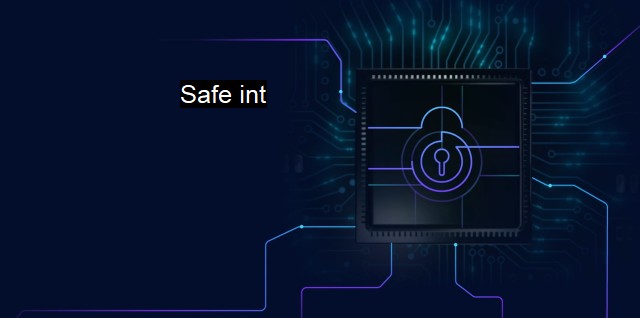What is Safe int?
Safe Int: An Essential Paradigm for Enhanced Cybersecurity and Antivirus Protection
In the realm of cybersecurity and antivirus software, the term 'Safe int', or 'Safe Integer', is a term that is fundamental to ensuring protection of a system’s data integrity and safe-footed encryption protocols. 'Safe int' narrates a narrative that revolves around the use of integers in cyber systems that can effectively be impedance to security breaches while augmenting the antivirus protocols in many unique ways.To delve deeper into the terminology, an integer is a basic data type in programming, representing a whole number, either positive, negative, or zero. In computer coding, numbers are stored in different formats, depending on their nature. decimals are often noted as "floats" or "doubles". Integers are denoted in the "int" format, being simpler in context and having a larger range as compared to other categories of numbers enlisted in a computer language.
What makes 'safe int' unique in cybersecurity and antivirus context is that not every integer that falls in the range of 'int' in a generic programming language is considered 'safe'. A 'safe int' is an integer that can be robustly represented and manipulated without the fear of encountering unexpected behaviour due to issues such as arithmetic overflow. These occurrences seem minimal but can often give away the encrypted security patches to cyber-criminals. Thus, the incremented emphasis on 'Safe int' in antivirus is seen.
In many systems, a 'Safe Integer' is one that - when involved in mathematical operations - will result in a precise value, not a rounded or approximate value. Therefore, it could be firmly posited that a safe integer is any integer that can 'safely' navigate a system or program, encompassing true data validity, without triggering errors, discrepancies or inadvertent exposure through its operation.
Errors like arithmetic overflow can result in discrepancies in the output, which may be exploited by an unwanted entity to gain illegal access to the system. This is where 'Safe Int' becomes an integral part of cybersecurity. Safe integers, by their inability to trigger overflow, serve as a pre-emptive measure to foil any unknown threats aimed at exploiting potential buffer overflow vulnerabilities.
Creating and ensuring 'safe ints' is something which is looked upon by the world of antivirus systems. Antivirus has algorithms woven around numerical values which are specifically designed to accept 'Safe Int' values to preserve data integrity and ensure correct configuration of detection processes and protocols.
Errors and vulnerabilities stemming from numerical inputs pose a significant risk and combating this requires comprehensive antivirus systems which intrinsically factor in 'Safe Ints' into their function. When antivirus systems conduct threat scans, the use of 'safe int' values minimizes the risk of calculation errors that can compromise systems’ health, illustrating not just a neat rebel, but a measure of proactive defence in cybersecurity operations.
As a practically applied example, JavaScript, defines a maximum and minimum safe integer - beyond which integers may not be safely handled. This feature or essence is commonly factored into antivirus checkpoints and security features to augment the resilience of cyber systems, adding further premeditated lines of defence.
'Safe Int' or 'Safe Integer' operates at the intersection of cybersecurity and antivirus protections. By striking a powerful balance between data validity and resilience, while mitigating mathematical and buffer overflow errors, 'safe int' practices consolidate antivirus and cybersecurity peripherals, making them more streamlined, error-free and efficient towards safeguarding a system. It anchors an immersive defensive schema manifesting progression towards a higher level cybersecurity protection, wagering against unprecedented exploits or possible corruptive maneuvers stemming from ambiguous or mismanaged integer inputs and processes within a cyber-architecture.
'Safe Int' serves as an emblematic entity outlining subtly and virtually nuanced yet powerful interactions, connotations and capabilities within the ambit of cybersecurity and antivirus infrastructure. Its existence and purpose within this robust framework is akin to the proverbial 'glue' that holds together a unison of intricate codes and complex narrative. As matter-of-factly eloquent these vals are, 'Safe Int' stipulates outlines of a safe-yard beyond integers, where information, data and processes stand resolute against veiling breaches beside cybersecurity architectures.

Safe int FAQs
What is Safe Int?
Safe Int is a programming technique used in cybersecurity to prevent integer overflow vulnerabilities. It ensures that the program will handle arithmetic operations on integers safely, preventing potential compromises of the system.What is integer overflow?
Integer overflow happens when the result of an arithmetic operation on integers exceeds the maximum value that can be represented by the data type, causing unexpected behavior and security issues in the program.How does Safe Int prevent integer overflow?
Safe Int uses techniques such as range checking and saturation arithmetic to ensure that the result of an arithmetic operation stays within the bounds of the data type. If an operation would result in an overflow, Safe Int either signals an error or clips the result to the maximum value allowed by the data type.What are the benefits of using Safe Int for antivirus software?
By using Safe Int, antivirus software can prevent potential security vulnerabilities caused by integer overflow, improve its overall security and reliability, and reduce the risk of attackers exploiting these vulnerabilities to bypass the security mechanisms in place.| | A | | | B | | | C | | | D | | | E | | | F | | | G | | | H | | | I | | | J | | | K | | | L | | | M | |
| | N | | | O | | | P | | | Q | | | R | | | S | | | T | | | U | | | V | | | W | | | X | | | Y | | | Z | |
| | 1 | | | 2 | | | 3 | | | 4 | | | 7 | | | 8 | | |||||||